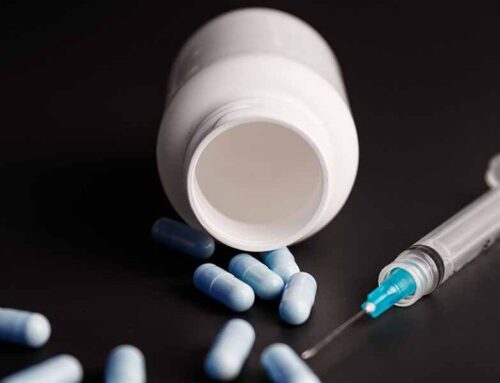
According to the Centers for Disease Control, as many as 1 in 5 Americans experience chronic pain. That’s more than 60 million people. Opioids are among the most popular painkillers. The trouble is that anything more than short-term opioid use inevitably leads to dependence.
This article discusses the crossroads between pain management and addiction and examines the options for pain management without the use of addictive drugs like opioids.
Where Pain Management and Addiction Meet
Opioid painkillers are effective. There’s no question that medicines like oxycodone (Percocet) and hydrocodone (Vicodin) work to control pain. So far we have still not found anything that works quite the same way opioids do for managing severe pain.
The trouble is that opioid dependence is unavoidable after a certain period of regular use. Becoming dependent on narcotic pain relievers isn’t a matter of willpower or discipline. Even if you follow your prescription and doctor’s orders precisely — if you take an opioid medication every day, or almost every day for more than a month or two, you will eventually become dependent on it.
Risks of pain management with opioid medications:
- Opioid dependence will occur, it’s only a matter of time.
- Addiction isn’t necessarily a certainty, but there is a substantial risk of it.
- Pain management clinics don’t always inform patients enough about addiction.
- Pain management patients who become addicted can, and do recover.
Dependence vs Addiction to Painkillers
People often confuse the terms dependence and addiction. They sometimes use them interchangeably. Unfortunately the word ‘addiction’ still has a certain amount of stigma attached to it. It shouldn’t. Addiction is a disease of the mind. It’s a mental health issue that has nothing to do with a person’s morality or self-control.
Breaking the stigma around addiction is one of the things that we are most passionate about at Georgia Addiction Treatment. No one should feel shame about addiction or dependence on pain medicine. It is critical to drive this point home, so we’ll say it again: Addiction is no one’s fault. There should be no blame or shame in the equation.
What’s the Difference Between Dependence and Addiction to Pain Meds?
It may be a subtle distinction between dependence and addiction, but it’s an important one. When you are dependent on an opioid pain medicine, your body chemistry has changed to adapt to its presence. This is something that happens naturally after a period of regular painkiller use.
If a person who is opioid dependent suddenly drops their dose by ¾ or stops completely, they will have physical withdrawal symptoms. These severe, flu-like symptoms occur because the body has become dependent on the medication to increase the level of a pleasurable chemical in the body called dopamine.
Addiction and Pain Management
Addiction on the other hand is also a form of dependence or reliance, except it is psychological rather than physical. A person becomes addicted when a substance becomes more important to them than it should be.
Eventually, it becomes the “answer” to everything. They prioritize finding and securing their supply of the substance over almost anything else. The idea of being without the substance is frightening to them. It is their only (or almost only) source of happiness and contentment.
A psychological reliance or addiction to painkillers can, and often does, happen at the same time as physical dependence. This can make getting off of painkillers really hard without the right kind of help.
Facts about pain management and addiction:
- Addiction among pain management patients is common.
- Becoming addicted to pain meds is nothing to be ashamed of.
- Pain management and addiction can be separated from one another.
- You can get effective pain management without addiction.
Concerns About Pain Management and Addiction
If you or someone you care about has become addicted to pain medication, you may be wondering how to escape this dire situation. No doubt you will have some fears about withdrawal symptoms. The biggest concern we hear in this situation though is about pain management without narcotic pain medication.
Many people are unaware that pain management without addictive drugs is even an option. Or they are misinformed and believe the only option is to remain addicted to opioids or suffer with their pain in sobriety. This is NOT the case at all.
Whether you’re dealing with an addiction to pain meds already, you simply don’t like being dependent on them or you are about to enter pain management for the first time and want to avoid the pitfalls of addiction — exploring non-narcotic pain management is a good idea.
So, How Can I Manage Pain Without Addiction?
The worrying uptick in opioid addiction in America during and after the OxyContin epidemic created more of a demand than ever for safer pain management without addictive drugs. This is one positive thing to come from that very difficult period in our history.
Here are some non-addictive pain management alternatives to consider:
Acetaminophen and Ibuprofen
Don’t underestimate the power of over-the-counter medicine. A clinical study revealed that when combined Tylenol (acetaminophen) and Advil (ibuprofen) are extremely effective at pain relief, much more so than either of them is alone. They’ve even outperformed opioids in some cases — and no, that’s not a misprint.
Long-Acting NSAIDs
The new class of longer-acting NSAIDs, like naproxen sodium, the active ingredient in the over-the-counter pain medicine Alleve, can be very effective for chronic pain. One of the reasons for their efficacy is that they can last for 12 hours or more. This makes it easier to keep your pain management even across the board and on schedule.
Bupivacaine and Lidocaine
Local anesthetics are pain management agents that work directly at the site where the pain occurs. They offer more rapid pain relief than any other option and the best part is they are not addictive or habit-forming. Lidocaine is even available at non-prescription strength in topical ointments, sprays, or patches.
Other Topical Pain Relievers
Topical pain relievers are similar to local anesthetics. However, they are exclusively applied to the skin. The advantage of topical solutions for pain management is that, like local anesthetics, they act right where the pain is and they go to work almost immediately. Look for Diclofenac, a topical NSAID. Another worth mentioning is capsaicin, extracted from hot peppers. Capsaicin also has the advantage of being naturally derived. Salon Pas patches are one example.
Start Overcoming Painkiller Addiction Today
Georgia Addiction Treatment Center is one of the most trusted substance use disorder treatment programs in the eastern U.S. We offer a full range of care options, including an affiliated residential medical detox.
If you or someone you care about is struggling with pain management and addiction, we’re here to help. Our comprehensive pain med addiction program has helped thousands of people get back their lives while managing pain without falling into the trap of addiction.
All it takes is a phone call to begin the healing. Reach us right now at: (855) 952-3546




